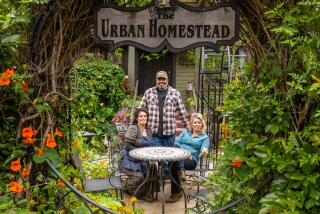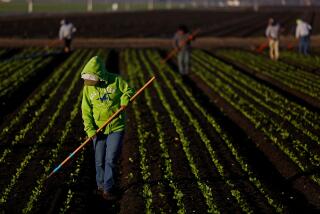Wanted: A New Breed of Dairy Imports
- Share via
BROOKINGS, S.D. — It looked like an Old West poster, a few hundred words promising a new life in America, tucked among news about cattle and sheep.
“WANTED -- Dairy Farmers!!!” said the ad, offering cheap land and grand opportunities for those who dare to become settlers in a new venture on foreign soil.
The place: South Dakota.
The time: now.
When Julie Scanlon and her partner, James Ailsby, first spotted the ad last fall in a British farm publication, they already had decided to sell their dairy in northwest England -- it had become too much of a financial drain.
They were considering farming in France. Or maybe Eastern Europe.
But the ad in “Farmers Weekly” offered a third choice: the wide-open plains of America, the same land that had lured hardy Europeans in the 19th century.
Sitting in the kitchen of their red-brick Victorian farmhouse, nestled among lush pastures and sturdy oak trees, the British couple mulled the offer. First, they were skeptical -- then, intrigued.
This spring, after selling their beloved cows -- Scanlon cried for months afterward -- they came here for a look, tooling around two-lane blacktops, scouting out fields of green, chatting with farmers.
By summer, they had decided.
Come September, they’ll bid farewell to their families, leave the picture-postcard village of Edale and travel 4,000 miles to the wind-swept prairie of South Dakota -- joining a tiny but growing number of Europeans becoming dairy farmers in America.
They’ll plunge into a world of high risk and hard work -- a combination that has forced thousands to flee the dairy business but one that does not discourage them.
“Nobody here says the roads are paved with gold or the sun shines all day,” Ailsby says. “But the opportunities are here. We’re glass-half-full rather than half-empty people. That’s the kind of makeup you need to consider doing this.”
*
Joop Bollen is looking for a few good farmers.
A decade ago, the Dutch-born Bollen was looking for a map to figure out where South Dakota was after being transferred here from Chicago to work as a grain trader.
These days, he’s South Dakota’s international recruiter, a trilingual ambassador who jets to trade shows and conferences in the Netherlands, England, Ireland and Canada, selling his state as the ideal place for dairy farming.
Bollen’s pitch is simple: The regulations are reasonable, the land plentiful, the business -- if all goes well -- profitable.
A large dairy farm, he says, can produce a six-figure income.
Many people Bollen meets have seen the “wanted” ads he places in European farm publications designed to look like those that brought homesteaders here in the latter 1800s -- including Laura Ingalls Wilder of “Little House on the Prairie” fame.
That parallel wasn’t lost on a British journalist who chose to interview the English couple at the nearby Wilder home-turned-museum -- then filmed part of his story in front of a covered wagon.
“Good luck, pioneers,” he said cheekily, as he left them days later.
Ailsby, in his Bart Simpson T-shirt, smiled good-naturedly.
Ailsby and Scanlon were respected farmers in England -- their 50-head herd was one of the top-milk producers in the country -- but they say low prices and new rules imposed after the “mad cow” scare took a toll.
“It’s a bit sad you can’t make a living in the country ... you’re brought up in, the place where you got your education,” Scanlon says. “But it’s very much a business decision.”
The couple are among about 15 families from Belgium, England, the Netherlands and Canada recruited by Bollen -- a number made more significant considering it translates into a $20-million-plus investment.
It takes moxie and money to make the trans-Atlantic move: Bollen estimates it costs each family at least $1 million to start from scratch, much less to buy an older place.
“The best people are the ones who are skeptical,” he says. “We don’t want them to romanticize this. It’s a serious step. You’re pulling out your roots completely and replanting them someplace else.”
Wim Hammink, a transplanted Dutch dairy farmer, walked away from a 400-year family tradition when he settled here.
“You’ve got to be a little bit of the pioneer, really,” he says. “There’s something you’ve got to have in your genes or blood.”
Even then, it’s risky.
“You’re not reinventing the wheel,” he says, “but adjusting it all the time.”
For Bollen, the recruitment is about much more than producing milk for cheese plants.
He’s convinced his efforts can help revive shrinking rural towns.
“The farmers get to sell their grain, the schools will get more kids, the local grocery store, the vet, the bookkeeper get business,” Bollen explains. “It’s one of the few chances these small communities have.”
The idea had dawned on others, as well.
Iowa State University is helping two towns and one county who are working with a Dutch company to pave the way for farm families migrating from the Netherlands.
In June, several Dutch dairy farmers came to scope out Iowa.
“The younger kids [in America] don’t want to stay on the farm,” says Louise Van Ersvelde, who coordinated the visit in Brooklyn, Iowa. “They want to go to college. They want to do their thing. Eventually they do come back ... but it may be too late.”
Many states -- including Ohio, Minnesota, Michigan and Texas -- have a smattering of recent foreign-transplant farmers, though precise numbers are hard to come by.
The laws remain a hurdle -- 30 states have some restrictions on foreign ownership of land, says Neil Harl, an Iowa State professor and agricultural economist.
Although many American businesses are foreign-owned, Harl says, some people believe land is different.
“It’s sacred,” he says. “It means you’re giving up part of your national identity.”
Harl also says some fear dairy farms are just the beginning and once foreigners “get a toehold ... it’s hard to tell what they might end up owning.”
The laws are fairly relaxed in South Dakota, Bollen says, and foreigners who settle here permanently can own unlimited land.
Bollen says it’s far easier to promote farming than it is to entice foreign manufacturers, although he does encounter the occasional quirky question.
“There are people who ask if we have earthquakes or if the Indians are still hostile,” he says.
Those who come research everything thoroughly, from the schools to weather patterns for 20 years.
That’s what Arjan Blok, a 30-year-old Dutchman, did before arriving last year.
Like many land-squeezed Europeans, he’s happy his neighbors are more than shouting distance away. He smiles when he describes a visit by his 83-year-old grandfather, Jan.
The elderly man dreamily scanned the big sky, savored the silence and, he says, told him: “If I was young and I saw all this space, I would have done it too.”
South Dakota is nearly five times the size of the Netherlands but has less than 5% of the population -- with an average of one person per 10 square miles.
An acre of farmland in the eastern part of the state -- where Bollen relocates people -- goes for $1,000 to $1,500. In Holland or Belgium, it could be $15,000 to $18,000.
And, Bollen says, the cost of living is low, the price of feed is cheap, there’s no personal income tax and, most important, there’s no quota system as there is in European countries, dictating how much milk farmers can sell.
Bollen even finds a silver lining in those teeth-chattering, blizzard-in-April winters.
“South Dakota has a good climate -- from a cow’s perspective,” he says deadly serious, pulling out a report that says cold is less stressful to the animals than heat.
It’s an appealing package, but not always a convincing one around here.
“I don’t think any of these people should assume it’s easier to make a living here,” says Dennis Wiese, president of the South Dakota Farmers Union. “Without government subsidies, people don’t make any money.”
Wiese says low milk prices and high property taxes in South Dakota have contributed to a mass exodus: A survey found nearly two-thirds of dairy farms in the state have disappeared in the last decade -- compared with a nationwide decline of more than 40%.
So although Europeans complain about quotas, Wiese says, at least the EU guarantees a price.
Wiese recently received an e-mail from a Swedish couple who inquired about buying farmland here. He was not encouraging.
“Anyone is welcome here,” he says. “That’s the great American dream. But the first thing I’d advise -- don’t quit your day job.”
*
The oversized hand-painted wooden shoes in Wim Hammink’s office -- a gift he received here -- are a reminder of a world he left behind.
But after eight years in South Dakota, Hammink has no regrets about moving.
“I’m still in the same business,” he says, “just in a different country.”
Hammink recalls when his family left Alemo, a town near the German border, some neighbors were enthusiastic but others were thinking “we’re just idiots. They’d say, ‘Why would we pick up and leave for the unknown?’ ”
But that’s precisely what millions of immigrants did.
His neighbors frequently noted their own European origins when he first settled near the tiny town of Bruce.
“They’d say, ‘My dad came from Denmark or my granddad came from Holland,’ ” he says. “So,” he pauses, and grins, “we’re really just two or three generations behind.”
Standing near a stall watching an hour-old calf try to gain his footing, Hammink is a contented farmer. But, he says, there was a steep learning curve: figuring out who to trust, understanding the tax system, adapting to American ways without abandoning his roots.
“We’re still proud we’re Dutch,” says his wife, Nicolien. “We don’t want to give that up yet.”
Hammink’s gamble paid off.
The 48-year-old farmer who tended 50 cows on about 60 acres in the Netherlands now has about 1,000 cows on 800 acres. (He owns half the land and rents the rest.)
He has a dozen employees and a consulting business, mentors other foreign farmers and has joined Bollen on his tours as a real-life success story.
Hammink still likes to visit family and friends in the Netherlands. But he feels at home here and says: “I’m feeling more American all the time.”
*
Soon, James Ailsby and Julie Scanlon will pack their “Butterscotch Holstein” sign and head west.
They’re not worried about the slow pace or loss of a social life: Scanlon has relatives in the United States and Ailsby jokes he’ll be fine -- he can buy Guinness here.
They don’t compare themselves to the pioneers of long ago -- “It’s an insult to their memory,” Scanlon says -- but their impressions of America echo of the past.
“It’s still a land of opportunity,” Ailsby says. “If we work hard and manage well, we’ll have a chance to make a decent living.”
“We might love it so much,” he adds, “we’ll want to stay forever.”
More to Read
Sign up for Essential California
The most important California stories and recommendations in your inbox every morning.
You may occasionally receive promotional content from the Los Angeles Times.










